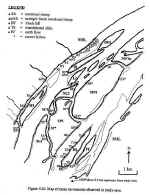|
2000, M.Sc.,
243 pp.
BANK
STABILITY OF THE LOWER REACHES OF THE MOOSE RIVER, NORTHERN ONTARIO
Dumbrell M.
 The riverbanks within the upper reaches of the Moose
River estuary have been analysed to detern1ine their stratigraphy, geotechnical
properties and stability. Rotational slumps, translational slides, block falls
and earth flows are the forn1s of mass movement identified within the study
area. Rotational slumps are the most common failure type and are particularly
concentrated along the north mainland banks characterized by a basal
glaciomarine unit (Tyrrell Sea clay) overlain by a thick silt unit and capped by
a thin organic soil layer. The rotational slumps commonly occur in the spring
and are associated with the sensitive basal stratigraphic unit (Tyrrell Sea
clay). The tidal inundation and exposure of the clay twice a day encourages
instability by promoting cracking which weakens the unit. Undercutting by the
river flow and the scouring by river ice during spring breakup further
destabilizes the bank. Coupled with an increase in pore-water pressure during
snowmelt (thereby decreasing the shear strength of the sediment), and the rapid
drawdown effect following the spring freshet, particularly after an ice jam, a
loss of sediment strength and change in support by the river results, and
large-scale failures occur. The riverbanks within the upper reaches of the Moose
River estuary have been analysed to detern1ine their stratigraphy, geotechnical
properties and stability. Rotational slumps, translational slides, block falls
and earth flows are the forn1s of mass movement identified within the study
area. Rotational slumps are the most common failure type and are particularly
concentrated along the north mainland banks characterized by a basal
glaciomarine unit (Tyrrell Sea clay) overlain by a thick silt unit and capped by
a thin organic soil layer. The rotational slumps commonly occur in the spring
and are associated with the sensitive basal stratigraphic unit (Tyrrell Sea
clay). The tidal inundation and exposure of the clay twice a day encourages
instability by promoting cracking which weakens the unit. Undercutting by the
river flow and the scouring by river ice during spring breakup further
destabilizes the bank. Coupled with an increase in pore-water pressure during
snowmelt (thereby decreasing the shear strength of the sediment), and the rapid
drawdown effect following the spring freshet, particularly after an ice jam, a
loss of sediment strength and change in support by the river results, and
large-scale failures occur.
|